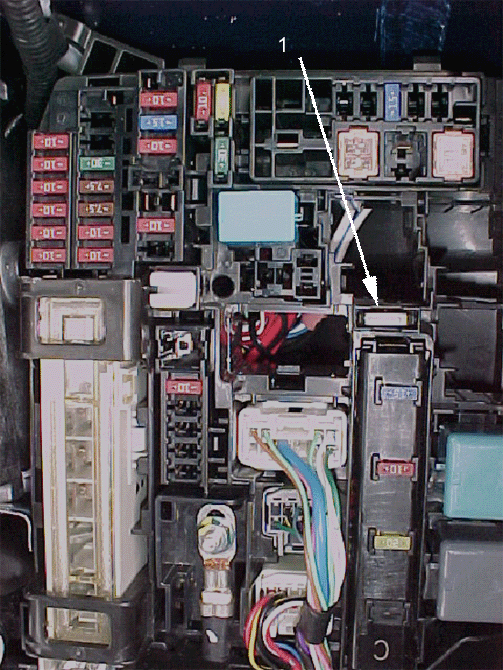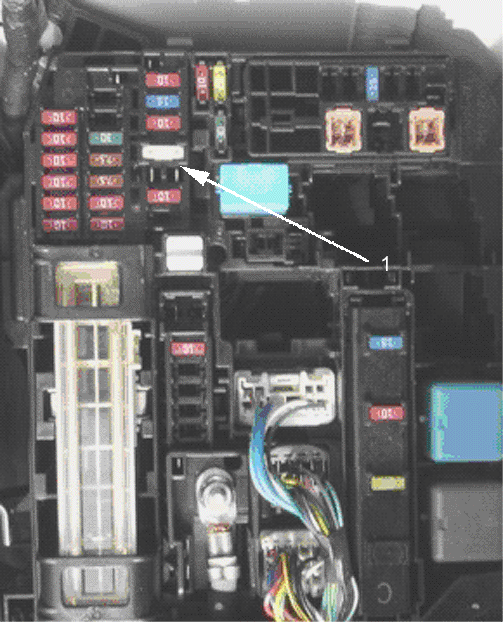Pre-Delivery Inspection (PDI) Information

| Subject: | Pre-Delivery Inspection (PDI) Information |
| Models: | 2009 Pontiac Vibe |
This bulletin is being revised to update the information under "Fuse and Underhood Fuse Block." Please discard Corporate Bulletin Number 08-00-89-002 (Section 00 - General Information).
PDI Concerns
Below are seven specific areas that need to be emphasized due to recognized concerns on delivered vehicles. These items are either unique to this vehicle or have significant impact on initial customer satisfaction.
Fuse in Underhood Fuse Block
Caution: The white unlabeled fuse MUST be installed in the correct location labeled "Short DCC." This fuse missing or incorrectly installed may result in an inoperative radio, dome lamp and/or remote keyless entry.
Shipping Location

All 2009 Vibes are shipped with a white unlabeled fuse (1) stored in a spare space in the underhood fuse block. The white unlabeled fuse is actually a power distribution connecting pin that connects battery voltage to the dome lamp, radio, and ECU-B fuses within the fuse block. With the connecting pin in the shipping location, the dome lamps, radio, OnStar® and remote keyless entry (RKE) are disabled.
In Pontiac Vibes with automatic transmissions and automatic door locks, all four doors will lock when the transmission is shifted out of park. It will not unlock when the ignition is turned off as they normally would. The vehicle stability control (VSC) light will flash and a DTC C1231 may be stored.
In order to regain complete operation of the power door locks, dome lamps, radio, OnStar®, VSC and RKE, the white connecting pin (1) must be removed from the spare location and installed into the "Short DCC" cavity as shown below This must be done as part of the PDI process.
Short DCC Location

The illustrations above show the white connecting pin installed in the shipping and "Short DCC" location. Refer to the underhood fuse block label to properly locate the "Short D.C.C." fuse location if there is any difficulty in finding the correct location.
Vehicle Transportation Tie-Down Underbody Inserts

There are two holes located in the vehicle underbody in front of the rear wheels (one hole each side) that are utilized for securing the vehicle during transportation. Two rubber plugs (found in the instrument panel compartment) are included with the vehicle to seal these holes in the underbody. You must install these caps to prevent water intrusion into the unibody which may cause excessive corrosion. Refer to the graphic above, which illustrates the passenger side of the vehicle (driver's side similar). The dark arrow indicates the position of the underbody cutout and the outlined arrow indicates the front of vehicle.
Interior Lamps Control
The interior lamps control is located on each overhead light. There is a front and rear dome lamp with a three position switch. The three positions are off, on and door. The vehicle was shipped with the dome lamps in the "off" position to prevent battery discharge. Be sure to set the dome lamps to the "door" position before delivering the vehicle to the customer.
Tire Pressure
Important: Tires MUST be set to the specified inflation pressure during the PRE-DELIVERY INSPECTION (including the spare tire).
Improper tire inflation pressures may result in ride, handling, and/or noise concerns. You MUST measure and adjust the tire inflation pressures during the pre-delivery inspection to the specification on the tire placard, NOT the pressure indicated on the sidewall of the tire. The tire placard is located on the driver's door lock pillar. General Motors vehicles are shipped from the factory with tire inflation pressures from 35 psi (241 kPa) to 41 psi (283 kPa). Tire inflation pressures are set higher at the assembly plants to prevent tire flat spots during transportation and storage.
Tire Pressure Monitoring (TPM) System
To operate the Tire Pressure Monitoring System under normal conditions, the TPM Electronic Control Unit (ECU) must be initialized with the tires at the specified tire inflation pressure. After adjusting all the tires to the specified inflation pressure, please perform following initialization of the TPM ECU at your dealership prior to delivery.
- Adjust all tires to the specified inflation pressure. Refer to the tire placard located on the driver's door lock pillar.
- Turn ON the ignition with the engine OFF.
- Push and hold the Tire Pressure Warning "SET" Switch (located under the steering column) until the Low Pressure Warning Light blinks 3 times. Ensure that the Low Tire Pressure Warning Light goes out.
Tip
If the Low Pressure Warning Light does not blink, release the Tire Pressure Warning "SET" Switch and repeat Step 3 again.
While the TPM initialization is in process, the tire pressure will be monitored. The TPM ECU will start to record vehicle data once the initialization is complete and will depend on the vehicle owner's driving patterns, habits, and trip duration. Once the data collection process is complete, the accuracy of tire pressure detection will be increased.
Front License Plate Bracket (if equipped)
For vehicles equipped with a front license plate mounting bracket, the bracket and two self-tapping mounting screws will be placed in the luggage compartment at the assembly plant. For states that require a front license plate, install the bracket and license plate according to the following procedure:
- Insert the license plate into the mounting bracket.
- Align the installation holes on the front license plate mounting bracket and license plate with the dimples on the front bumper fascia.
- Screw the two self-tapping screws directly into the dimples to install the license plate and mounting bracket.
Important: Do not pre-drill holes in the dimples.
Do not over-tighten the self-tapping screws.Get-To-Know-You Guide (U.S. Only)
The Get-To-Know-You Guide will be hung from the shifter and should be left in place during PDI. This contains important information for the customer to become familiar with their new vehicle.
